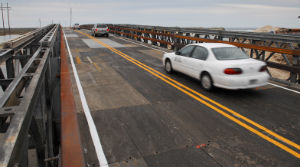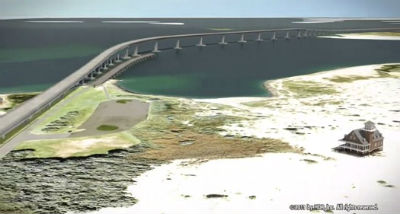Reprinted from the Island Free Press
 Superstorm Sandy last year buckled N.C. 12 near Rodanthe on Hatteras Island. Photo: Nicholas School of the Environment, Duke University |
NAGS HEAD — Beach erosion and ocean overwash are hardly the only headaches the state Department of Transportation has with the Herbert C. Bonner Bridge replacement project.
The public comment period on the proposed bridge over Pea Island Inlet closed last week, and transportation officials will review input from agencies and the public to determine if the project warrants further environmental study. If not, construction could begin this summer on a permanent bridge to replace a temporary one that DOT built to span an inlet created by Hurricane Irene in 2011.
Supporter Spotlight
But two pending legal challenges have the potential to hinder or even stop progress on that bridge, a new bridge over Oregon Inlet and permanent fixes to N.C. 12. The main road on the Outer Banks has been battered by storms in recent years, particularly the section just south of the inlet.
“The construction on the bridge will not be able to begin until the legal matter is resolved,” Jerry Jennings, a DOT division engineer, said of the new bridge over Oregon Inlet. “We will continue to make repairs to the existing bridge as needed until we can start construction.”
Jennings said that work on a test pile is currently being done on the northern end of the 50-year-old bridge, and scour at the base of three piles is also being addressed.
A ruling on a lawsuit filed in July 2011 in U.S. District Court in New Bern by environmental groups opposed to the project is expected any time, said Victor Barbour, DOT technical services administrator.
“All of the information is in the judge’s hands,” he said. “She’s had it several months. We’re at the mercy of the judge right now.”
Supporter Spotlight
 The state plans to replace a temporary bridge that it built after Hurricane Irene in 2011 opened a new inlet on Pea Island with a permanent structure. Photo: NCDOT |
Judge Louise Flanagan will be making a summary judgment based on her review of reams of documents submitted to her by both sides.
Any ruling against DOT will likely also affect the construction of the 2.1-mile bridge in Pea Island, said Beth Smyre, the DOT project manager. The legal challenge includes the permanent fixes for breaches in N.C. 12 on Pea Island and Rodanthe during Hurricane Irene.
The Pea Island alternative was chosen to replace the temporary bridge on the south end of the refuge. The preferred alternative for the Rodanthe location will be announced by summer.
Plaintiffs Defenders of Wildlife and the National Wildlife Refuge Association, represented by Chapel Hill-based Southern Environmental Law Center, contend that DOT and the Federal Highway Administration violated the National Environmental Policy Act by not adequately addressing all alternatives for replacing the Bonner Bridge and maintaining N.C 12.
The groups favor building a 17.5-mile bridge that bypasses Oregon Inlet or use of high-speed ferries.The so-called causeway bridge or ferries, the plaintiffs say, will provide more reliable access to Hatteras Island.
Both options, DOT responded, are not viable, largely because of high initial costs. The agency’s most recent study of ferries also concluded that the required dredging would be extensive and environmentally damaging and that no high-speed ferry currently exists that could safely transport vehicles in heavily-shoaled Outer Banks inlets.
A letter-writing campaign against the project launched last week by Defenders of Wildlife again proposed ferries as a transportation solution for Hatteras Island.
Whether the judge rules in favor of DOT or the environmental groups, the losing side is expected to appeal, Barbour said. The judge could then allow the project to continue pending the outcome of the appeal, suspend the project or parts of it, put conditions on it or issue whatever order she chooses.
There is currently no injunction on the project and it is not clear why DOT is waiting for the ruling before construction begins. When the lawsuit was first filed, the agency had indicated it would continue until the court ordered otherwise.
“Initially, the plan was to start earlier this year,” Jennings said. “All along they’ve known the issues were ongoing.”
 A visualization of the new bridge over Oregon Inlet. Photo: NCDOT |
The contractor for the Oregon Inlet bridge, he said, can start anytime now. DOT awarded the $215.8 million contract in July 2011 to design-build team PCL Civil Constructors Inc. and HDR Engineering Inc. of the Carolinas.
“They’ll be ready to react when they have the decision on the lawsuit,” Jennings said.
Another legal matter could also gum up the works.
In November, the Southern Environmental Law Center asked a judge to review its challenge to the project’s Major CAMA Permit that was issued in September. Simply put, the state permit allows construction of the Bonner replacement.
The chairman of the state Coastal Resources Commission, Bob Emory, in October had denied the group’s request for a third-party hearing on the permit.
Attorneys have recently filed briefs on the matter in Wake County Superior Court, said CRC spokeswoman Michele Walker.
Meanwhile, Barbour said the CAMA permit is still in place. The DOT is awaiting approval of a wetlands permit and the Coast Guard permit for the Oregon Inlet bridge.
He said the three-year project continues to have support from legislators and the governor, and he expects it will be able to be completed by 2016 or 2017, including demolition of the old Bonner Bridge.







